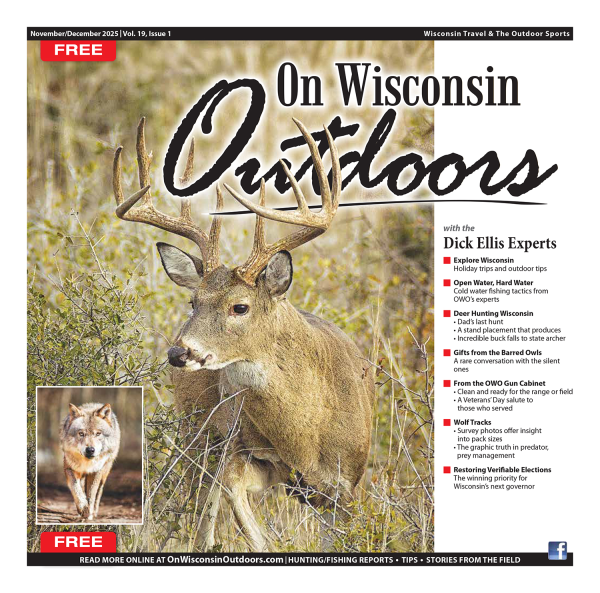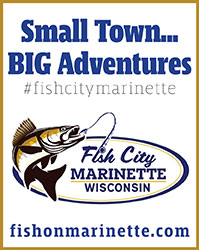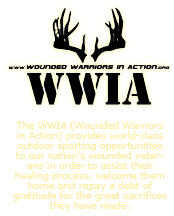DNR Weekly News Update for December 11, 2018
Published - December 11, 2018 by the Central Office
- Wisconsin State Park System campers can set up accounts with new reservation system beginning Dec. 14
- Release of additional pheasants for holiday season provides opportunity to spend time with family and friends pursuing upland birds
- Conservation biologist share 2018 Fields Notes success stories for rare and native wildlife
- Weekend warm-up: DNR does not monitor ice; ask locals for local conditions
- Nominations sought for Hunter Ethics Award honoring character, not harvest
- Prune oak trees in winter to help prevent oak wilt
- Comments sought on DNR strategic analysis of aquatic plant management in the state
- 38 communities, groups receive urban forestry grants
- Wisconsin Natural Resources magazine ushers in the season with beauty of winter photos
- Incidental take notices for Lafayette and Monroe counties
Wisconsin State Park System campers can set up accounts with new reservation system beginning Dec. 14
Contact(s): Chris Pedretti, state parks business operation chief, 608-264-8958 or Paul Holtan, DNR Office of Communications, 608-267-7517
MADISON - Wisconsin State Park System customers can log into the new reservation system to set up their new accounts beginning at 9 a.m. on Friday, Dec. 14. Starting at 9 a.m. on Dec. 17, 2018 customers can begin making reservations using the new, improved - and less expensive - reservation system.

The new Wisconsin State Park System reservation website will go live on Dec. 14 to set up accounts and Dec. 17 to make reservations.Photo credit: DNR
People will be able to reach the new reservation system at wiparks.net or by searching the Wisconsin Department of Natural Resources website, dnr.wi.gov, for keyword "camp." All reservations that have already been previously booked will automatically be transferred to the new Camis system. All campers who have reserved sites for next year will receive an email confirming their reservations transferred to the new system. Anyone who has questions regarding their reservations can call the customer service line at 1-888-947-2757 beginning at 9 a.m. on Dec. 17.
The Wisconsin Department of Natural Resources is contracting with a new provider, Camis USA, Inc., that was awarded the reservation contract through a competitive bidding process. Camis USA currently operates reservation systems for Michigan, Maryland and Washington state parks.
No new reservations can be booked until Dec. 17. Customers who do not have current reservations only need to set up an account in the new system to begin making reservations with Camis USA.
Under the new system it will cost users $7.75 to make a reservation, compared to the previous price of $9.65. Customers can also expect many enhancements when making reservations, including better searchability for campsites, and a mobile-friendly website that makes it easier than ever to make a reservation from a phone or tablet. The new system will also accommodate reservations for shelters and amphitheaters. Customers can make reservations for sites up to 11 months in advance of their arrival, either online or by phone. The reservation phone number (1-888-947-2757) and access to the online reservation system through the DNR website will remain the same.
________________________
Release of additional pheasants for holiday season provides opportunity to spend time with family and friends pursuing upland birds
Contact(s): Mark Witecha, DNR upland wildlife ecologist, (608)-267-7861
MADISON -Department of Natural Resources staff will help bird hunters beat cabin fever this December - 2,160 pheasants will be stocked on eight different properties in southern Wisconsin during the week leading up to the winter holidays.
With the popularity of last year's late-season stocking, the department will expand its efforts for the 2018 holiday pheasant stocking event, supported by the new hatchery facility.

Cabin fever is no match for time spent pursuing pheasants with family and friends.Photo credit: DNR
Cabin fever is no match for time spent pursuing pheasants with family and friends.
Properties to be stocked before the holiday season include:
- Mud Lake Wildlife Area, Columbia County;
- Mazomanie Unit of Lower Wisconsin State Riverway, Dane County;
- Richard Bong State Recreation Area, Kenosha County;
- Brooklyn Wildlife Area, Dane & Green counties;
- Avon Bottoms Wildlife Area, Rock County;
- Waterloo Wildlife Area, Jefferson County;
- Sauk Prairie Recreational Area, Sauk County; and
- Vernon Wildlife Area, Waukesha County.
"We selected properties with suitable cover for pheasant hunting near population centers," said Mark Witecha, DNR upland wildlife ecologist. "The department hopes this late-season stocking will provide an opportunity to get out and enjoy the outdoors with family and friends, and perhaps add some additional table fare to your holiday meal."
As a reminder, quality pheasant hunting opportunities exist throughout Wisconsin, including wild pheasant hunting where suitable habitat exists and previously stocked public lands. The pheasant season runs through January 6, 2019. All hunting regulations and bag limits apply through the season close, see the 2018 Small Game Regulations for more information.
Hunters are reminded to practice TABK while afield:
- T - Treat every firearm as if it is loaded;
- A - Always point the muzzle in a safe direction;
- B - Be certain of your target and what's beyond it; and
- K - Keep your finger outside the trigger guard until ready to shoot.
In addition, hunters are encouraged to wear blaze orange while upland bird hunting to increase visibility with other hunters.
For more information regarding pheasant hunting in Wisconsin, visit dnr.wi.gov and search keyword "pheasant."
________________________
Conservation biologist share 2018 Fields Notes success stories for rare and native wildlife
Contact(s): Drew Feldkirchner, Director, DNR Natural Heritage Conservation Program, 608-235-3905
MADISON - Thousands of acres of monarch habitat maintained or restored on public lands. Tiny rare turtles and bats outfitted with transmitters to reveal secrets to help save their species. Rare wild orchids pollinated by hand to boost their survival.
 "Field Notes" highlights work in 2018 to conserve Wisconsin's natural heritage.Photo credit: DNR
"Field Notes" highlights work in 2018 to conserve Wisconsin's natural heritage.Photo credit: DNRThese are just some of the stories shared in the "Natural Heritage Conservation Program Field Notes," a 16-page publication from the Wisconsin Department of Natural Resources Natural Heritage Conservation Program in partnership with Wisconsin Natural Resources magazine. Find the 2018 Field Notes and companion videos by searching the DNR website, dnr.wi.gov, for "NHC annual report."
"These Field Notes describe a few ways we worked together with partner agencies and organizations, citizen scientists and donors to care for Wisconsin's rare plants, wildlife and special places," says Drew Feldkirchner, who directs the DNR Natural Heritage Conservation Program, NHC for short.
"There is much to celebrate in these pages and in our companion videos. We are very thankful for the time, effort and donations of so many. Together we are making a difference."
Natural Heritage Conservation staff are responsible for protecting, managing and restoring rare and native wildlife and plants and hundreds of State Natural Areas. These public lands serve as refuges for rare species and for the best remaining examples of prairies, oak savannas, wetlands, forests and unique geological and archaeological sites. The vast majority of these lands are open to the public for wildlife watching, hiking, hunting and other nature-based activities.
Feldkirchner says the 2018 Field Notes also highlight many ways people can get involved in caring for these natural resources.
"We know that even with the gains made in 2018 there is still much work ahead. More than one-third of the United States' fish and wildlife species are at risk of becoming endangered. Our job is to prevent that from happening, and we can't do it without you."
Volunteers can choose from dozens of citizen science projects to help collect valuable information about the location, number and trends of native species. There are also many opportunities to lend a hand on State Natural Areas, including some of Wisconsin's most unique areas, by cutting brush, pulling invasive plants, and collecting seeds and other work. Look for opportunities in the coming weeks.
Thousands of donors provide critical financial support; their donations to the Endangered Resources Fund are matched dollar for dollar and account for up to 25 percent of the funding needed for NHC's work with rare species and State Natural Areas. People can make tax-deductible donations online or by mail directly, or through their state income tax form. They also can buy an Endangered Resources licenses plate that includes a $25 annual donation to the Endangered Resources Fund.
________________________
Weekend warm-up: DNR does not monitor ice; ask locals for local conditions
Contact(s): Joanne Haas, DNR Bureau of Law Enforcement, 608-209-8147; Capt. April Dombrowski, DNR Safety and Outdoor Skills Section, april.dombrowski@wisconsin.gov
MADISON - It's not January but a thaw is in the works, and Wisconsin Department of Natural Resources conservation wardens urge all outdoor enthusiasts and ice fishers to check with their local shops, fishing clubs and outfitters for local ice conditions before venturing out.
Capt. April Dombrowski of the DNR Bureau of Law Enforcement Recreation Safety and Outdoor Skills Section, says early season ice conditions vary greatly from waterbody to waterbody and with these temperature swings. This is why she stresses to all: No ice is safe.
"Since we at the Department of Natural Resources do not monitor ice conditions, we urge all who enjoy the outdoors to first check with local bait shops, fishing clubs, snowmobile clubs and outfitters for those local ice conditions," Dombrowski said. "These are the places locally most likely to have the most current information about the lakes and areas."
Dombrowski says extreme caution is always recommended when the topic is ice. "Even though it may look thick on the surface, moving water from streams, rivers and springs can cause ice to form unevenly."
She offers these tips for anyone considering going on the ice:
- Know before you go. Don't travel in areas you are not familiar and don't travel at night or during reduced visibility.
- Dress warmly in layers and consider wearing a life jacket or vest.
- Do not go alone. Head out with friends or family. Take a cell phone and make sure someone knows where you are and when you are expected to return.
- Avoid inlets, outlets or narrow that may have current that can thin the ice.
- Look for clear ice, which is generally stronger than ice with snow on it or bubbles in it.
- Carry some basic safety gear: ice claws or picks, a cellphone in a waterproof bag or case, a life jacket and length of rope, and a spud bar to check ice while walking to new areas.
- Wear creepers attached to boots to prevent slipping on clear ice and take extra mittens or gloves so you always have a dry pair.
- If you go through the ice:
- Carry a set of ice picks in your pocket to help you climb out of the ice hole.
- Once out of the water, do not stand up. Rather, walk on your forearms until the majority of your body is on solid surface.
- Try to remain calm, call for help and take steps to get out of the water as soon as possible.
Common sense is the greatest ally in preventing ice related incidents. One rule of thumb remains the same. Treat all ice as unsafe.
The DNR also has information on its website about what to do should you fall through the ice and how to make ice claws. Learn more by searching the DNR website, dnr.wi.gov, for "ice safety."
________________________
Nominations sought for Hunter Ethics Award honoring character, not harvest
Contact(s): Joanne Haas, DNR Bureau of Law Enforcement, 608-209-8147
LA CROSSE, Wis. -- First awarded in 1997, the annual Wisconsin Department of Natural Resources Hunter Ethics Award recognizes the hunter whose action are emblematic of Wisconsin's hunting heritage - which is not about trophy bucks or number of pheasants - of an outdoor tradition enjoyed responsibly, respectfully and safely by and for all.
DNR Chief Warden Todd Schaller, also a member of the award committee, says ethical behavior often means going above and beyond.
"That means actions that help another during a hunt, or taking steps to ensure the resources are there for all," Schaller said. "In past years, award recipients have returned lost gear, helped others find lost game or assisted another hunter facing a challenge of some kind."
Anyone - hunter or non-hunter -- can nominate a licensed Wisconsin hunter for the award for an action that took place during the calendar year of 2018. While many nominations are made during gun-deer season, the ethical action could be something done during a squirrel hunt, turkey hunt, waterfowl hunting or any other Wisconsin hunting season.
A four-person committee studies the nominations and selects the person judged most deserving of this award. The annual honor was established by Bob Lamb, retired outdoors editor of the La Crosse Tribune, retired DNR conservation warden supervisor Steve Dewald and retired University of Wisconsin-La Crosse biology professor and outdoors writer Jerry Davis.
Simply send the name, address and other contact information to Chief Warden Todd Schaller, by email or letter and explain what the ethical act was. The nomination committee focuses on what are often singular actions or events rather than individuals who have long term conservation related programs.
To become eligible for the 2018 award:
- The nominee must be a licensed (resident or nonresident) Wisconsin hunter.
- The ethical hunting act must have occurred in Wisconsin during the 2018 calendar year.
- Nominations will be considered for any DNR-regulated hunting activity, not only deer hunting, in Wisconsin.
Written nominations must contain the name, address and telephone number of the witness or witnesses, or be aware of the behavior, which led to the nomination. Mail to Chief Conservation Warden Todd Schaller at Todd.schaller@wisconsin.gov or to Wisconsin DNR, Attention: Chief Warden Todd Schaller LE/5, PO Box 7921, Madison, WI 53707-7921, by Jan. 15. 2019.
________________________
Prune oak trees in winter to help prevent oak wilt
Contact(s): Paul Cigan, DNR forest health specialist, Paul.Cigan@wisconsin.gov, 715-416-4920 or Don Kissinger, DNR urban forestry specialist, Don.Kissinger@wisconsin.gov, 715-348-5746
MADISON -- It may not sound like fun, but winter in Wisconsin is an excellent time to prune oak trees. Pruning in winter offers all the benefits of pruning while minimizing the spread of tree diseases. One such disease is oak wilt, a fatal tree disease that spreads through tiny sap-feeding beetles attracted to open wounds on trees.
"Dormant trees in winter are easier to prune because damage is much more visible on tree branches after their leaves have fallen, and pruning is more effective because harmful pests are inactive in cold temperatures," said Paul Cigan, forest health specialist in northwestern for the Wisconsin Department of Natural Resources.

Two oaks, one in the process of wilting and the other having almost no leaves left, is a sure sign that Oak Wilt is active.Photo credit: DNR
Trees should be pruned throughout their entire life to maintain strong structure and remove dead wood. Young trees should be pruned to establish a central trunk, proper trunk taper, and good branch structure and spacing. Older trees should be pruned to remove dead and/or hazardous limbs. But pruning oaks during warmer months of April through July places them at greatest risk for oak wilt infection and should be avoided where possible.
While oak wilt often spreads locally through tree injury, it can also move greater distances on or in firewood logs. Taking recommended precautions, such as pruning in winter, and keeping firewood local will help protect trees in your area and prevent the spread of oak wilt to new counties and townships.
"Several recent oak wilt finds in northern Wisconsin, including first finds in Bayfield and Douglas counties and in over a dozen new northern townships, may have been the result of infected firewood brought from areas with oak wilt," Cigan said.
Experts recommend keeping oak firewood at the same location where it is cut for one year, or until the bark is naturally loose, to prevent the spread of oak wilt.
The DNR offers a pruning brochure with more detailed, step-by-step tips for tree pruning. Find it by searching the DNR website, dnr.wi.gov, for keywords "tree pruning." Certified arborists who offer pruning and other tree care services can be found at waa-isa.org/arborists/search.asp (exit DNR). For additional information about oak wilt, search the DNR website, dnr.wi.gov, for keywords "oak wilt."
________________________
Comments sought on DNR strategic analysis of aquatic plant management in the state
Contact(s): Carroll Schaal, lakes and rivers section chief, 608-261-6423 or James Pardee, environmental analyst, 608-316-0999
MADISON-The Department of Natural Resources invites the public to comment on its draft Strategic Analysis of Aquatic Plant Management (APM) in Wisconsin. The report, which summarizes current information on APM in the state, serves as an informational resource to help decision-makers and the public to better understand the topic and to aid in the development of future APM policy.
Aquatic plants are a critical part of the state's freshwater environment. They help to ensure good water quality and clarity, provide habitat and food for fish and wildlife, and serve many other valuable functions. Sometimes, though, aquatic plants can become overabundant and interfere with water uses. Managing these problems is complicated by the fact that some of the DNR rules governing APM have not been updated since 1986, while APM practices and challenges have evolved.
The draft Strategic Analysis report [PDF] and links to more information about APM can be found by searching the DNR website, dnr.wi.gov, for APM strategic analysis, or "aquatic plant management."
Comments on this strategic analysis may be submitted through January 25, 2019, by email to DNRAPMSA@wisconsin.gov or sent via US Mail to Carroll Schaal, lakes and rivers section chief, 101 S. Webster Street, Madison, WI 53707-7921.
________________________
38 communities, groups receive urban forestry grants
Contact(s): Sarah Zimmerman, 608-640-6682
MADISON -- Thirty- Wisconsin communities, nonprofit groups, and counties will share over $532,000 in 2019 state grant dollars to promote and sustain urban forest resources in Wisconsin.
The Department of Natural Resources Urban Forestry Grant program funds projects that are consistent with state and national goals for increasing the urban forest canopy and the benefits it provides. The urban forest encompasses trees on both public and private property.
Priorities for the 2019 grant cycle include, but were not limited to, projects that increase the ability of local municipal partners to expand their urban forestry program; increase the ability of all local partners to provide ongoing urban forestry funding, services and/or markets; benefit multiple communities; and put existing inventories of urban trees to use.
"Wisconsin's urban forests provide a wide range of ecological, economic and social benefits for the 70 percent of Wisconsin's population that lives in an urban area and visitors to these communities," said Sarah Zimmerman, DNR urban forestry grant manager. "Beyond aesthetics, urban forests reduce air pollution, mitigate storm water runoff, conserve energy, and increase property values. The 2019 urban forest grants help communities maximize these benefits."
DNR forestry officials encouraged communities to apply for grants to develop emerald ash borer management plans and raise public awareness regarding its impact on ash trees in their community. Increasing species diversity is the best way to reduce the impact of future tree diseases or insect infestations.
The grants range from $1,000 to $25,000, and grant recipients must match each grant dollar for dollar. A startup grant of up to $5,000 is available for communities that want to start or restart a community forestry program. Out of the 38 2019 Urban Forestry grants awarded, 12 are for startup grants.
For list of selected grant recipients [PDF] and more information about the DNR urban forestry grant program, search the DNR website, dnr.wi.gov, for keywords "UF Grant."
________________________
Wisconsin Natural Resources magazine ushers in the season with beauty of winter photos
Contact(s): Magazine editors Andrea Zani, 608-267-9517 or Kathy Kahler, 608-266-2625
MADISON - A winter magazine deserves a winter theme and the latest issue of Wisconsin Natural Resources has it. The quarterly magazine published by the Wisconsin Department of Natural Resources ushers in the season with a six-page spread of spectacular cold-weather photos. From frozen lakes to fishing shanties, these "Freeze Frames" taken by contributor Tim Sweet of Appleton capture the beauty of winter.
Also in this issue, a story about "One foggy morning on the Mississippi" tells of a would-be eagle rescue effort, while "Early advantages" describes the joys and challenges of the early catch-and-release trout season. "The nature of healing" explores the therapeutic power of the outdoors, highlighting programs at northern Wisconsin's Northwest Passage mental health treatment center for youth.
Two essays - "Buck of a lifetime" and "It's what hunters do" - speak to the state's compelling culture of hunting and the emotions it evokes. The essays are illustrated with historic drawings from Jim McEvoy, who for decades worked as a DNR staff artist.
McEvoy's images are a nod to the DNR's 50 years of history, which has been celebrated by the magazine throughout 2018. Another story, "NRB turns 50," also touches on that theme, marking the golden anniversary of the DNR's guiding body, the State of Wisconsin Natural Resources Board.
While those pieces look back, another magazine story looks ahead. "DNR's next 50: Thriving in a digital age" tells of numerous established and emerging technologies being used by the agency in its mission to protect Wisconsin's valuable natural resources.
Other standing features include "Reader's Write" letters and feedback, a winter message from DNR Secretary Dan Meyer and "Outside in Wisconsin," highlighting Copper Falls State Park.
One more piece strikes a sad note. In October, the former longtime editor of Wisconsin Natural Resources, David "Larry" Sperling, died unexpectedly at age 66. The Winter magazine's regular "Back in the day" feature is devoted to Sperling and includes an excerpt from his own 2001 writing on ice fishing, a piece that resonates with Sperling's distinct and amiable voice.
Wisconsin Natural Resources magazine is available for $8.97 per year. Subscribe at 1-800-678-9472 or online at wnrmag.com.
________________________
Incidental take notices for Lafayette and Monroe counties
Contact(s): Stacy Rowe, 608-266-7012
MADISON - Two proposed projects could result in the "incidental taking" of rare species in Lafayette and Monroe counties under authorizations the Wisconsin Department of Natural Resources proposes to issue for the projects. Incidental take refers to the unintentional loss of individual endangered or threatened animals or plants that does not put the overall population of the species at risk.
The Wisconsin Department of Transportation proposes to replace the State Highway 78 bridge crossing the Pecatonica River in Lafayette County. The presence of the state endangered Blanchard's cricket frog (Acris blanchardi) has been confirmed in the vicinity of the project site. DNR staff determined that the proposed project may result in the incidental taking of some frogs.
Proposed improvements include removing and replacing the bridge deck. Guardrail at all corners of the bridge will be removed and replaced, which requires grading on the existing slopes. Fifty feet of existing asphalt on both approaches of the structure will be milled and overlaid with new hot mix asphalt to blend into the new bridge deck. Existing asphalt shoulders will be removed and replaced to accommodate the new guardrail installations.
A proposed We Energies project involving the construction of approximately 16 miles of 12-inch gas main may result in the incidental taking of a rare moth and lizard in Monroe County. The Sparta Lateral Project, which was approved by the Public Service Commission of Wisconsin, extends from the Town of La Grange, east of Tunnel City, to the City of Sparta. The project.
The presence of the state endangered phlox moth (Schinia indiana) and state endangered slender glass lizard (Ophisaurus attenuatus) have been confirmed in the vicinity of the project site. DNR staff determined that the proposed project may result in the incidental taking of some moths and lizards.
Department staff concluded that in both cases the proposed projects will minimize the impacts to the species by adhering to conservation measures; is not likely to jeopardize the continued existence and recovery of the state population of the species or the whole plant-animal community of which it is a part; and has benefit to the public health, safety or welfare that justifies the action.
The conservation measures to minimize the adverse effects on the endangered species will be incorporated into the proposed Incidental Take Authorization. Copies of the jeopardy assessment and background information on the Blanchard's cricket frog are available by searching the DNR website for incidental take public notice or upon request from Stacy Rowe (608-266-7012 stacy.rowe@wi.gov). The department is requesting comments from the public through January 10, 2019 regarding project-related impacts to the Blanchard's cricket frog. Public comments should be sent to Stacy Rowe, Wisconsin DNR, PO Box 7921, Madison, WI 53707-7921 or stacy.rowe@wi.gov.
________________________












